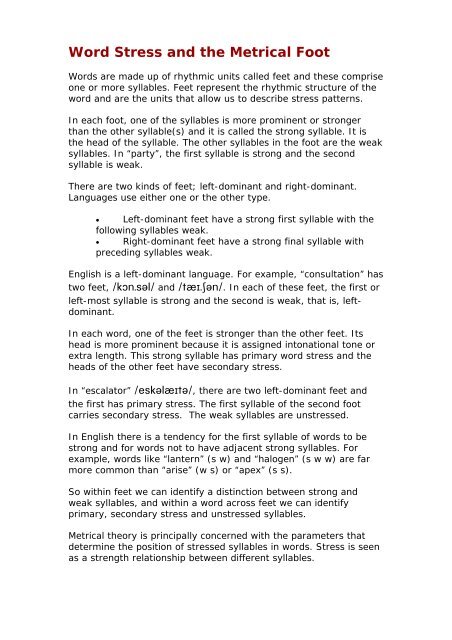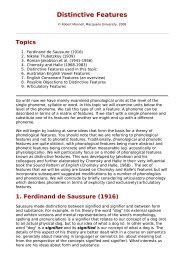The Syllable and the Foot : Summary - Speech Resource Pages
The Syllable and the Foot : Summary - Speech Resource Pages
The Syllable and the Foot : Summary - Speech Resource Pages
Create successful ePaper yourself
Turn your PDF publications into a flip-book with our unique Google optimized e-Paper software.
Word Stress <strong>and</strong> <strong>the</strong> Metrical <strong>Foot</strong><br />
Words are made up of rhythmic units called feet <strong>and</strong> <strong>the</strong>se comprise<br />
one or more syllables. Feet represent <strong>the</strong> rhythmic structure of <strong>the</strong><br />
word <strong>and</strong> are <strong>the</strong> units that allow us to describe stress patterns.<br />
In each foot, one of <strong>the</strong> syllables is more prominent or stronger<br />
than <strong>the</strong> o<strong>the</strong>r syllable(s) <strong>and</strong> it is called <strong>the</strong> strong syllable. It is<br />
<strong>the</strong> head of <strong>the</strong> syllable. <strong>The</strong> o<strong>the</strong>r syllables in <strong>the</strong> foot are <strong>the</strong> weak<br />
syllables. In “party”, <strong>the</strong> first syllable is strong <strong>and</strong> <strong>the</strong> second<br />
syllable is weak.<br />
<strong>The</strong>re are two kinds of feet; left-dominant <strong>and</strong> right-dominant.<br />
Languages use ei<strong>the</strong>r one or <strong>the</strong> o<strong>the</strong>r type.<br />
• Left-dominant feet have a strong first syllable with <strong>the</strong><br />
following syllables weak.<br />
• Right-dominant feet have a strong final syllable with<br />
preceding syllables weak.<br />
English is a left-dominant language. For example, “consultation” has<br />
two feet, /kɔn.səl/ <strong>and</strong> /tæɪ.ʃən/. In each of <strong>the</strong>se feet, <strong>the</strong> first or<br />
left-most syllable is strong <strong>and</strong> <strong>the</strong> second is weak, that is, leftdominant.<br />
In each word, one of <strong>the</strong> feet is stronger than <strong>the</strong> o<strong>the</strong>r feet. Its<br />
head is more prominent because it is assigned intonational tone or<br />
extra length. This strong syllable has primary word stress <strong>and</strong> <strong>the</strong><br />
heads of <strong>the</strong> o<strong>the</strong>r feet have secondary stress.<br />
In “escalator” /eskəlæɪtə/, <strong>the</strong>re are two left-dominant feet <strong>and</strong><br />
<strong>the</strong> first has primary stress. <strong>The</strong> first syllable of <strong>the</strong> second foot<br />
carries secondary stress. <strong>The</strong> weak syllables are unstressed.<br />
In English <strong>the</strong>re is a tendency for <strong>the</strong> first syllable of words to be<br />
strong <strong>and</strong> for words not to have adjacent strong syllables. For<br />
example, words like “lantern” (s w) <strong>and</strong> “halogen” (s w w) are far<br />
more common than “arise” (w s) or “apex” (s s).<br />
So within feet we can identify a distinction between strong <strong>and</strong><br />
weak syllables, <strong>and</strong> within a word across feet we can identify<br />
primary, secondary stress <strong>and</strong> unstressed syllables.<br />
Metrical <strong>the</strong>ory is principally concerned with <strong>the</strong> parameters that<br />
determine <strong>the</strong> position of stressed syllables in words. Stress is seen<br />
as a strength relationship between different syllables.
















